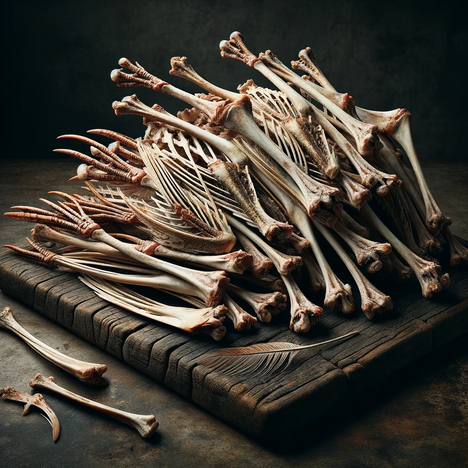Pheasant bone

The search for the optimal diet for our four-legged friends often leads us down unexpected paths. We come across ingredients that may seem unusual at first glance, but can potentially provide valuable nutrients for our dogs. One such example is pheasant bones. These by-products of pheasant hunting and breeding could be an interesting addition to our dogs' diet. But what exactly are pheasant bones, and what are their advantages and disadvantages? This article takes you on a journey through the world of pheasant bones in dog nutrition.
What are pheasant bones?
Pheasant bones are the bones of the pheasant, a game bird prized both for its meat and for sport hunting purposes. In dog nutrition, they can be used raw or as part of specially prepared bone meals. As well as providing a source of calcium and other minerals, they can also help to clean teeth and keep dogs occupied.
Benefits of pheasant bones
Natural source of minerals
Pheasant bones are an excellent natural source of calcium and phosphorus, two minerals that are essential for building and maintaining strong bones and teeth in dogs. They also contain other trace minerals that can contribute to overall health.
Supporting dental hygiene
Chewing on raw fiber bones can help reduce tartar and plaque in dogs. The mechanical action of chewing cleans the teeth naturally and can help maintain oral health.
Occupation and behavior promotion
Chewing on bones can be an enriching activity for dogs, helping them to combat boredom and satisfy natural chewing instincts. It can also help reduce unwanted chewing behavior on furniture or other inappropriate objects.
Possible disadvantages and risks
Risk of bone splinters
Raw fed fiber bones, especially the smaller ones, can splinter and form sharp edges that can injure a dog's mouth, esophagus or digestive tract. This risk is particularly high in smaller dogs or dogs that tend to gulp their food rather than chew thoroughly.
Nutritional imbalances
Excessive intake of fibrous bones can lead to an imbalance in the calcium to phosphorus ratio, which can cause long-term health problems. It is important to feed bones in moderation and ensure that the overall diet remains balanced.
Availability and hygiene
As with other wildlife products, the availability of pheasant bones can be limited and their quality variable. In addition, raw bones always carry the risk of contamination with bacteria such as salmonella, which can pose a health risk to both dogs and humans.
Fibrous bones can be an interesting addition to your dog's diet, as they provide important minerals and support dental hygiene and natural chewing behavior. However, it is crucial to be aware of the potential risks and take appropriate precautions. This includes choosing suitable bones, monitoring your dog's chewing and integrating bones into a balanced diet.
If you notice any signs of hypersensitivity or poisoning in your dog, you should see your vet immediately. We are not a substitute for a vet, but we try to be as accurate as possible. Every dog reacts differently and we recommend you get a second opinion or consult your vet if in doubt.
Stay healthy and take good care of your four-legged friend!😊
Similar to Pheasant bone
Duck bones, as the name suggests, come from ducks. They can be fed in various forms, including raw as part of a BARF (Biologically Appropriate Raw Food) diet or cooked in home-cooked meals. While...
Chicken bones are bones from chickens, which are usually a waste product from meat processing. They consist of collagen, a protein that gives bones stability, and minerals such as calcium and...
Quail bones, as the name suggests, come from quails - small birds known for their tender meat. Unlike the bones of larger animals, quail bones are finer, smaller and softer. This makes them a...
Pigeon bones are, as the name suggests, the bones of pigeons. They tend to be smaller and more tender than the bones of many other meat sources used in dog food. These characteristics could make...


